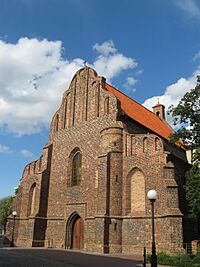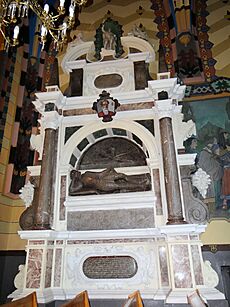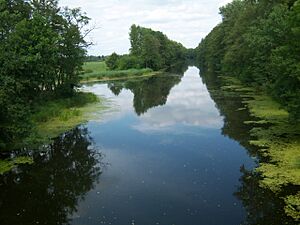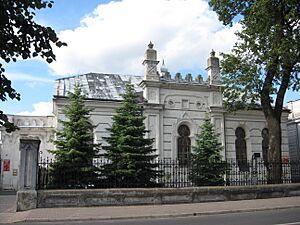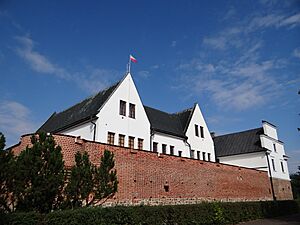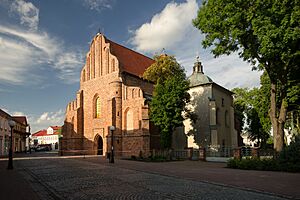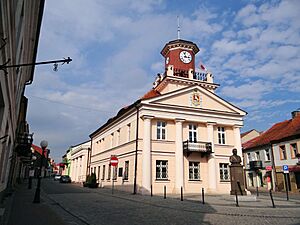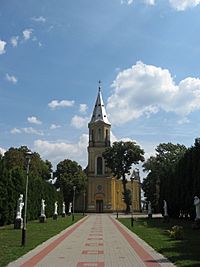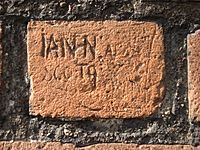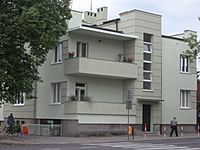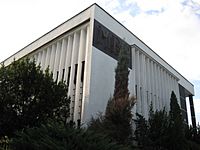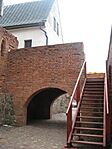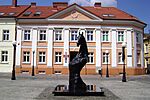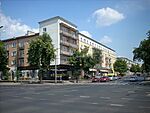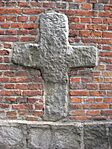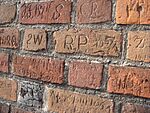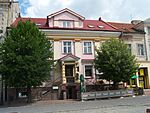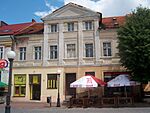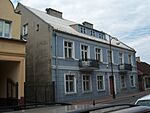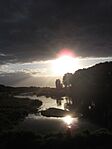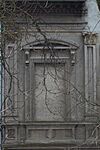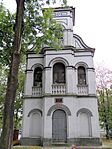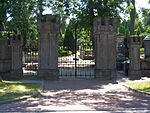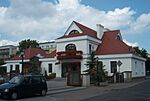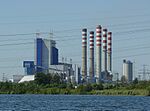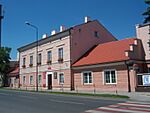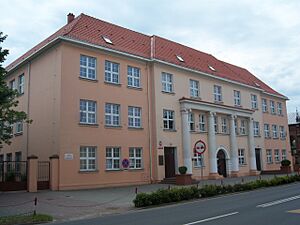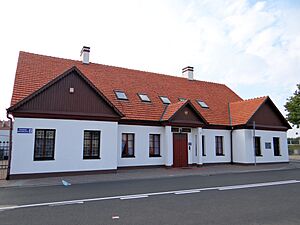Konin facts for kids
Quick facts for kids
Konin
|
|||
|---|---|---|---|
|
|||
|
|||
| Country | |||
| Voivodeship | |||
| County | city county | ||
| City rights | 1284 | ||
| Area | |||
| • Total | 82 km2 (32 sq mi) | ||
| Elevation | 88 m (289 ft) | ||
| Population
(31 December 2021)
|
|||
| • Total | 71,427 |
||
| Time zone | UTC+1 (CET) | ||
| • Summer (DST) | UTC+2 (CEST) | ||
| Postal code |
62-500 to 62-510
|
||
| Area code(s) | +48 063 | ||
| Climate | Dfb | ||
| Car plates | PKO, PN | ||
| Website | http://www.konin.pl | ||
Konin is a city in central Poland, located on the Warta River. It is the main city of Konin County and is part of the Greater Poland Voivodeship. Before 1999, it was the capital of the Konin Voivodeship. In 2021, Konin had a population of 71,427 people. This makes it the fourth-largest city in Greater Poland, after Poznań, Kalisz, and Piła.
Contents
History of Konin
Early Human Settlements
The oldest signs of people living in Konin date back to the Stone Age. Scientists have found ancient tools made of flint near the Warta River. These tools include knives and other items from the Swiderian culture, which existed around 9000–8000 BC.
Konin in Ancient Times
A lasting settlement grew in the Konin area along the Amber Road. This was an old trade route from the Roman Empire to the Baltic Sea. An ancient map by Ptolemy called this place Setidava. It was likely a spot where people could cross the Warta River. It also had an important market for traders. Old burial grounds from the 2nd and 3rd centuries AD have been found here.
Konin in the Middle Ages
In the early Middle Ages, a strong settlement called Gród Kaszuba existed near Konin. People lived there from the 10th to the 12th centuries. It was built on meadows near the Warta River. Floods likely caused people to leave this settlement. You can still see its remains on the south bank of the river.
During the 12th and 13th centuries, a group of settlements grew around what is now called Stare Miasto (Old Town). This area had a large settlement named Konin, a market, and a church made of sandstone. The name Stare Miasto was used later, after Konin moved to a new spot.
The SS Peter and Paul's Parish Church still stands from that time. It has a beautiful carved entrance and a solar clock on its south wall. This might be the oldest solar clock in Greater Poland. In 1331, the Teutonic Knights attacked and burned the settlement. What was left was soon abandoned.
The town of Konin was then rebuilt about 6 kilometers (4 miles) northeast. This new spot was easier to defend and is where the Old Town of Konin is today.

Since the 13th century, Konin has been on marshy ground, like an island in a shallow part of the Warta River. The oldest document confirming the town's location is from 1293. It mentions Gosław, a leader of settlers. Przemysł II, the Duke of Greater Poland, might have officially given Konin its town rights. He visited Konin in 1284 and 1292.
At that time, Konin was about 430 meters (1,410 feet) long and 210 meters (690 feet) wide. Its total area was eight hectares (20 acres), and its outer edge was 1,100 meters (3,600 feet) long. For that time, Konin was a medium-sized town.
Konin became more important in the 14th century. Records show that Konin had a Castellan, a high official in old Poland. Only the oldest towns had this honor. Around the mid-14th century, Konin became the legal center of the Kalisz Voivodeship. It was led by a Starost. There might have been a school in Konin then, as a student from Konin is listed in a 14th-century record from Charles University in Prague.
The late 14th and 15th centuries were a time of fast growth for Konin. During the rule of Polish King Casimir III the Great (1310–1370), a king's castle was built in Konin. The town was also surrounded by walls and a moat. This marked Konin as a king's town. Later, King Władysław II Jagiełło (1351/52 - 1434) visited Konin in 1403, 1425, and 1433. He helped weaken the Teutonic Knights by winning the Battle of Grunwald in 1410. His longest stay in Konin was in 1433. He stayed in the castle that summer, getting updates on a Polish attack against the Knights.
In 1458, during the Thirteen Years' War (1454–66) against the Teutonic Order, Polish towns had to provide soldiers. Konin had to send 15 infantrymen. For comparison, Poznań, the capital of Greater Poland, sent 60. This shows Konin was still a medium-sized town. The town continued to develop its crafts and expand its district. In 1425, Konin was allowed to hold two fairs each year.
The Renaissance Period
The 16th century was a "golden age" for Poland, with much growth. In 1504, the village of Kurów, across the river from Konin, became part of the town. A description from 1557 mentions a brickyard, a mill, and many craftsmen. These included eight butchers, 14 bakers, 21 shoemakers, and four fishermen.
Konin might have been one of the smaller towns in eastern Greater Poland at this time. This is based on its "Szos," a tax on earnings. Konin paid 32 zlotych, while Poznań paid 1400 zlotych.
In terms of religion, the local leader of Konin, Jakub Ostroróg, supported Protestants. A local priest, Stanisław Lutomirski, also played a role in the Protestant Reformation in the Konin area.
Challenges in the 17th Century
The 17th century brought many problems to Konin, including diseases and wars. A plague from 1628 to 1631 greatly reduced the town's population. To help the town recover, King Władysław IV announced in 1646 that Konin could hold two fairs each year. He offered military protection to merchants who attended. In 1652, a local leader allowed the Scottish community in Konin to build breweries.
However, the town was invaded and taken over by the Swedish Army in 1656 during the Second Northern War (also called The Deluge). Konin suffered a lot of damage. The number of houses dropped from 127 before the war to just 25 in 1659. By the end of the war, only about 200 people lived in the town. Another plague hit in 1662.
Konin in the 18th Century
The 18th century started with the Great Northern War. Konin was so badly damaged in 1707 that it took the rest of the century to rebuild. The second half of the century was a difficult time for Poland. The Polish–Lithuanian Commonwealth declined, leading to the Partitions of Poland. Poland lost its independence and its land was divided among Russia, Prussia, and Austria.
After the second partition in 1793, Konin became part of Prussia. This ended Konin's status as a royal town. At that time, Konin had 780 people and 165 houses, with only one made of brick. People made a living from farming and crafts. There were 22 shoemakers, 13 potters, and eight furriers. Eight fairs were held each year, along with cattle round-ups. The main groups of people were Poles, Jews, Germans, and Scots.
In 1794, Konin joined the Kościuszko Uprising, a Polish rebellion. Polish rebels took control of the town several times. For example, in September 1794, soldiers led by Jan Henryk Dąbrowski entered the town. Dąbrowski is the person the Polish national anthem is named after. In 1796, a fire damaged the town.
Konin in the 19th Century
The 19th century began with the Napoleonic Wars across Europe, which also affected Konin. At the start of the century, the Duchy of Warsaw was created as a Polish state. It was formally independent but actually depended on Napoleon I Bonaparte. Poles hoped to regain independence and strongly supported Napoleon. On November 9, 1806, Poles took control of Konin and quickly set up a new town government. The next year, Konin officially became part of the Duchy of Warsaw.
When Napoleon's empire fell, a new order was set in Europe and in Polish lands, including Konin. The Congress of Vienna (1814–1815) gave most of the former Polish–Lithuanian Commonwealth lands to Russia. Konin became part of Congress Poland, a region controlled by Russia. The Russian ruler (tzar) was its head. Konin was also made the capital of a district within the Kalisz Governorate. This district included Konin County and Pyzdry County. Konin's district was the westernmost part of the Russian state.
The November Uprising began in 1830. Konin was not directly involved, but like other Polish cities, it suffered the results of the rebellion's failure. Poles were denied higher jobs, Polish was no longer the official language, and schools were systematically forced to use Russian.
The January Uprising of 1863 had a bigger impact on Konin. Many battles and small fights happened in and near Konin. Many monuments today mark these events.
From 1815 onwards, trade and crafts grew a lot in Konin. A description from 1820 states that among 2,456 people, there were 161 craftsmen, ten merchants, and 42 farmers. Konin's population steadily increased, from 4,195 in 1850 to 7,391 in 1896. While nearby Łódź became a major textile center, Konin only had 12 small cloth workshops in 1820.
In the 1830s, the town was renewed. New streets and squares were built. Land was set aside for factories, and old buildings were torn down.
By the end of the century, Konin had two factories making machines and tools for farming. The larger one belonged to L. Reymond from Switzerland. His factory had a 12-horsepower steam engine and a cast iron foundry. The town also had 18 windmills, four tanneries, four soap workshops, three vinegar factories, two small boiler factories, two breweries, two oil-mills, a sparkling water factory, and a distillery.
Konin in the 20th Century
The early 20th century was a time of fast growth for Konin in culture, education, and social life. The Musical Society of Kalisz had 72 members in Konin. Konin's Jewish Library was one of the best in the Kalisz region, with many books and readers. A branch of the Rowing Club of Kalisz was started in Konin in 1908 and had 95 members by 1914. Its building still stands in Old Konin.
Workers' groups were also formed in Konin. In 1905, when big strikes happened in Polish industrial cities like Warsaw and Łódź, Konin also saw some smaller strikes and unrest.
A branch of the Polish gymnastic society Sokół was founded in Konin. This group aimed to keep teenagers fit and healthy, and to prepare them for possible military service. Similar Jewish and German groups also existed.
After World War I began in 1914, battles between Russian and German troops happened near Konin. The city then came under German control and suffered. In November 1918, when Poland became independent again, German soldiers fired on Polish scouts and students trying to free the city. Germans also threw grenades at people gathered in the Market Square, killing six and wounding many.
Despite this, Konin was soon part of the reborn Polish state. However, the town's economy did not improve much. Living conditions were still poor, made worse by a lack of water and sewer systems. The economic crisis between the wars was hard. Conditions only started to get better when a major railway between Poznań and Warsaw opened, and a canal to Gopło Lake was built. In the 1930s, Jews made up 30% of Konin's population.
During Second World War, Konin was taken over by Nazi Germany. During the German occupation, Germans committed mass murders of Poles at the local Jewish cemetery in November 1939 and spring 1940. Ninety-four people were killed, some as part of the German Intelligenzaktion (a plan to kill Polish leaders) and some as punishment for defending Poland in September 1939.
The Germans also set up a Nazi prison and two forced labor camps for Jews in the city. Poles were also forced out of their homes in late 1939 and 1940. Their homes, shops, and workshops were given to German settlers as part of the Lebensraum policy (living space for Germans). Three Polish men from Konin were also killed by the Soviets in the Katyn massacre in April–May 1940.
In the forests around Konin, the Nazis carried out mass killings of Jews. About 95% of the Jewish population was killed or sent to concentration camps. In August 1943, Jews at the labor camp in Konin tried to escape by burning down their huts. Almost all of them were killed.
Jewish Community of Konin
The first written record of Jews living in Konin is from 1397. In the 15th century, 180 Jews lived in the city. During the 17th century, the number of Jews decreased due to fires, plagues, and rules limiting where Jews could live. Until the late 18th century, the Jews of Konin were part of the larger Jewish community in nearby Kalisz.
A wooden synagogue was built in 1763–1766. The current building was built in 1829. The first rabbi in Konin was Rabbi Amsterdam, who served from 1810 to 1849.
Between the two world wars, about 3,000 Jews lived in Konin, making up about a quarter of its residents. In 1918, the first Jewish high school (Gymnasium) was started. The community had a study hall (beit midrash), ritual baths (mikvaot), synagogues, and prayer halls. They also had active youth groups, a library, and Jewish elementary and high schools. Groups like Agudat Yisrael, Beitar, other Zionist parties, and the Bund were active there. Most Jews in Konin were Mitnagdim, but there were also small groups of Hasidim, mainly followers of Gerer Hasidism and Aleksander Hasidim.
The Germans occupied Konin in September 1939. Soon after, the area was made part of the German Reich. In late 1939, about 1,000 Jews from Konin were sent to a settlement near Radom. In 1940, the Germans forced the remaining Jews into a ghetto. Their former homes were given to German officials and ethnic Germans. Later that year, more groups of Konin's Jews were sent to other ghettos, allowed to take only a few items. By the end of 1940, almost all had been deported.
In November 1941, some Konin Jews were among the 3,000 Jews killed by German SS in the forests of Kaziemesh (Kleczew), north of the city. Out of 6,000 Jewish people living in Konin before the German occupation, perhaps 200 survived the war. Only 46 returned to Konin. None of them stayed in Konin due to the unfriendly attitude of the non-Jewish population.
In 1968, the town's survivors published a large memorial book (Yizkor book) of 803 pages. It remembered the thriving Jewish community. The book was written in Yiddish, Hebrew, and English.
Theo Richmond, a descendant of Konin Jews, wrote Konin: A Quest. This book is the most detailed history of Jewish life in the town available in English. It won the Jewish Quarterly-Wingate Prize in 1996.
Castles in Konin
The 14th-century castle in Konin was built from brick and sandstone. It was shaped like a square. The main buildings were large, with an eight-sided watchtower in the southeast corner. The castle also had two walls and a moat around it. During the Deluge in the 17th century, the Swedish army partly damaged it. It was then left to decay. The old castle was torn down in the 19th century. Today, nothing remains of it. Castle Square (Plac Zamkowy) is roughly where the castle once stood.
Another castle, built in the 15th century in the former Gosławice village (now Konin's Gosławice district), was restored in the 1980s.
Ancient Town Walls
The town walls, like the castle, began to be built in the second half of the 14th century. They protected the town, especially on its south and east sides, and partly on the west. The walls never fully enclosed the town. The Warta River, with its marshy grounds and earthworks, provided enough protection in the gaps.
On the north side of town, the Toruńska Gatehouse (Brama Toruńska) stood near the river crossing. On the south side, the Kaliska Gatehouse (Brama Kaliska) guarded the town. Both gates were named after important towns that merchants traveled to from Konin.
The walls were made stronger by rectangular towers that stuck out, like small forts. These towers had three walls and were open on the side facing the town. These defenses were badly damaged during the Deluge, especially during the 1656 siege of Konin. They were never fixed. By the early 18th century, the town decided to take them down. The last parts were removed after 1816. Today, no remains of the ancient town walls can be seen.
Architectural Landmarks in Konin
Konin County has many types of old buildings. You can find Romanesque, Gothic, Renaissance, Mannerist, Baroque, and Rococo styles. There are also 18th-century Classicism buildings, and 19th-century Neo-Gothic, Neoromanesque, Neoclassicism, and Eclecticism styles. In the 20th century, Modernism, Nazi architecture, Socialist Realism, and Postmodernism were used. Near Konin, you can also see remains of concrete bunkers used by Poland's Poznań Army during World War II.
The city of Konin has two main historical parts: Old Town (Stary Konin), which is south of the Warta River, and New Konin (Nowy Konin), which grew north of the river mostly after 1945.
- Romanesque Style
- The Stone Signpost of Konin is the oldest signpost in Europe outside the former Roman Empire. It was made in 1151 AD from local sandstone. Some experts think the stone might have been an old Celtic sculpture.
- St Bartholomew's parish church was rebuilt in the late 14th century. But you can still see its Romanesque features on the outside walls, especially the north wall. These include carved stones and a large stone cross built into the wall.
- Gothic Style
- St Bartholomew's Parish Church is Konin's best example of Gothic architecture. It has a Gothic net and vault inside, and stained glass windows in the altar area.
- St Andrew's Church, in Konin's Gosławice district, is a rural Gothic church. It has an unusual Greek cross shape and a rare fan vault ceiling. The external walls are decorated with many coats of arms.
- The 15th-century medieval castle in Gosławice is now a regional museum. It was built between 1418 and 1426. It was designed to be defended with firearms. Gosławice has a unique collection of old buildings, including its ancient village, Gothic church, medieval castle, and an old Polish manor house.
- Renaissance Style
- On the grounds of St. Bartholomew's Church is the Late Renaissance chapel of Jan Zemełko (Zemelius). He was a local doctor and a well-known person in Konin and Kalisz.
- Jan Zemełko's former home, on Plac Wolności, has been updated many times. However, the main hall still has its original barrel vault ceiling. The ground floor walls are very thick (1 to 2 meters).
- Mannerist Style
- The Mannerist tombstone of Stanisław Przyjemski is on the north wall of the main part of St. Bartholomew's Parish Church.
- Mannerist wooden stalls with detailed inlaid work are found in the Chapel of Jan Zemełko.
- Baroque Style
- St. Bartholomew's Parish Church has many Baroque altars, memorials, and stalls. A Late Baroque wall crucifix hangs in the porch. The church organ is also Late Baroque and dates from the 18th century.
- The Baroque monastery and church building at St. Mary Magdalene's Church of Reformed Franciscans were built in 1631.
- Rococo Style
- At St. Bartholomew's Parish Church, Rococo elements are seen in the wall crucifix above the porch entrance on the north wall. They are also in the main altar of the Chapel of Jan Zemełko.
- Classicist Style
- The Town Hall, built in the early 19th century, has a front with four tall Toscany Columns supporting a large triangular roof (pediment). Above the pediment is a small tower with a clock and a tall flagpole for the Konin flag.
- Old Town has many Classicist apartment buildings and a former butcher's shop in the same style, near the Town Hall.
- The Municipal Council Building, near Plac Wolności, is also in the Classicist style.
- The Presbytery of the Lutheran Church of the Holy Ghost is a Classicist manor house. It is in a small garden in the center of the Old Town.
- Neo-Gothic Style (19th and 20th centuries)
- St Bartholomew's Parish Church has a Neo-Gothic main altar made of wood, decorated with many Neo-Gothic statues.
- St Andrew's Church, in the Gosławice District, was originally Gothic. It was updated in the Neo-Gothic style. Its central tower and the fronts of its chapels were built in the 19th century.
- Eclectic Style (19th and 20th centuries)
- The Lutheran Church of the Holy Ghost, built in 1856 and rebuilt later, shows an Eclectic style. It was built when Konin was under Russian control and looks a bit like Russian Orthodox churches. It is made of dark brick, and its large main tower has spires and many decorations.
-
- St. Adalbert's Church, in the Morzysław District, was built in the 18th century on the site of an older wooden church. It was completely renovated and enlarged in the early 20th century. This made it an impressive large church with a tall main tower and a high spire. This church also shows a slight influence of Russian Orthodox architecture.
-
- Many apartment buildings in Old Town have eclectic fronts, showing features from many different architectural styles.
- Other examples of Eclecticism in Konin are the Jewish buildings, including the Konin Synagogue, the ritual baths, and the Talmudic schoolhouse. These were built in the 19th century. The synagogue, built in 1832 and renovated in 1883, is considered one of the most beautiful of its kind in Greater Poland. Its south side mixes Moorish and Neo-Gothic styles. The north side is simpler, mainly using Classicist elements.
-
- The Romani Gypsy palaces on ulica Stodolniana and ulica Europejska in the Old Town are impressive. They have onion domes and sculptures shaped like small, decorated medieval castles. Built mostly in the 1980s and 1990s, they are unique in the city's residential areas.
- Modernism: Pre-War (1920–1939)
-
- Ulica Szarych Szeregów 1 is a striking renovated apartment building. It was built in the 1930s. During World War II, it housed the offices of the Nazi Gestapo, where prisoners were tortured. After 1945, it was used by the Communist secret police. Today, it contains private apartments.
- Ulica 3 Maja 48 is a good example of pre-war Modernism. The Guild of Handicrafts (Cech Rzemiosł Różnych) is located there, along with various shops.
- Modernism: Post-War (1945-1960s)
- The town's library (Miejska Biblioteka Publiczna / MBP), on ulica Dworcowa, is a large, cube-shaped Modernist building. Concrete ribs divide its windows, and its black and white front stands out against the green surroundings. Before it was a library, it was a branch of the National Bank of Poland.
- The Dino Supermarket on ulica Dworcowa, once the Centrum Department Store, has an upper front covered entirely by tilted glass.
- Nazi Architecture
- Several examples of Nazi architecture exist in Konin. These include a row of buildings on ulica Kolejowa in New Konin, built as homes for railway workers. Across the street is a monument remembering a Jewish uprising in August 1943. Another group of Nazi buildings is in the Old Town, near ulica Szpitalna. This area is locally known as Heimat, highlighting its German connection.
- Socialist Realism
- Aleje 1-go Maja (Avenue of the First of May), the main street of Nowy Konin, has the city's earliest examples of Socialist Realism architecture. These include the hospital and various public buildings. Since New Konin was mostly built after the Communist government took power in 1946, it has many buildings in this simple, Socialist Realism style.
- Osiedle V (Housing Estate No. 5), built in the 1970s and early 1980s, has blocks of flats in straight rows, without much decoration. This shows the economic difficulties of People's Republic of Poland at that time.
- The Zatorze District, built in the 1980s, has large blocks of flats made from pre-made, gray concrete parts. Shops and schools in the same style are also there.
- Postmodernism
- About 10 kilometers (6 miles) from Konin is the huge Basilica of Our Lady of Licheń. This church is an example of Catholic Postmodernism and is the world's sixth largest Christian church.
- The PKO BP S.A. bank and office building at ulica 11-go Listopada (Eleventh of November) 20 was one of the first large buildings built in Konin after the fall of Communism in Poland in 1989. It has elements of Socialist Realism but also includes Postmodernist features new to Konin.
- The Skarpa office and commercial building at ulica Energetyka 6b was finished in the early 2000s. Its practical design and interior match its subtly decorated outer walls, which are covered with wide strips and plates in an inox (stainless steel) color. The outside pavement is made of granite blocks, and the inside floors have dark granite plates.
PTTK (Polish Tourist and Sightseeing Society)
Konin is located where some of Poland's most historic lands meet: Greater Poland, Cuiavia, Mazovia, and Łódzkie. Because of this, the local branch of the Polish Tourist and Sightseeing Society is very active. People from other countries are also interested in the signs and monuments of the many different groups who have lived in Konin over centuries. These include Jews, Scots, Germans, Frenchmen, Russians, Romanis, Czechs, Swiss, Dutch Olędrzy, Vietnamese, Chinese, Romanians, and Africans.
Konin was also one of the towns along the Scottish Trail. This route went through cities in Greater Poland and Lower Silesia. It connected the different Scottish trading communities who settled in Poland from the 15th century onwards.
Gallery
Education in Konin
Konin has several places for higher education:
- Wyższa Szkoła Kupiecka in Łódź, which has a branch in Konin.
- Państwowa Wyższa Szkoła Zawodowa (The State School of Higher Professional Education in Konin). You can find more info at http://www.pwsz.konin.edu.pl/
- Akademia Humanistyczno-Ekonomiczna in Łódź, which also has a branch in Konin.
Sports in Konin
Konin is home to a few sports teams:
- Górnik Konin - a football (soccer) team. They currently play in the Polish fourth division. They also played in the second division in the 1990s and 2000s. In 1998, they were the runner-up in the Polish Cup.
- KKPK Medyk Konin - a women's football (soccer) team. They play in the top division and have won the Polish championship multiple times.
Greenpeace Climate Rescue Station
Greenpeace chose Konin to set up its Climate Rescue Station. They built a four-story globe replica that could power itself. It was placed next to the Jozwin IIB open-cast coal mine. Greenpeace wanted to show how much Poland relies on coal. This was part of their campaign to share their message at the United Nations' global warming Conference in nearby Poznań. Most local people welcomed Greenpeace. Hundreds came to join activities and listen to talks about the environment. The Rescue Station later moved to Poznań.
Notable People from Konin
- Mieczysław G. Bekker (1905–1989), a Polish engineer and scientist.
- Krystian Bielik (born 1998), a Polish Footballer.
- Szymon Bobrowski (born 1972), a Polish actor.
- Antoni Czubiński (1928–2003), a Polish historian.
- Julius Fromm (1883–1945), a Polish-German business owner, chemist, and inventor.
- Gosław, the first known leader of settlers in Konin from 1293 CE.
- Leopold Infeld (1898–1968), a Polish physicist.
- Marcin Kamiński (born 1992), a Polish footballer.
- Jarosław Iwaszkiewicz (1894–1980), a Polish poet, essayist, playwright, and writer.
- Reni Jusis (born 1974), a Polish pop singer, songwriter, and producer.
- Jan A. P. Kaczmarek (born 1953), a Polish Academy Award-winning composer.
- Józef Lewandowski (1923–2007), a Polish-born Swedish historian.
- Przemysł II (1257–1296), a Polish ruler who might have founded Konin by signing a charter for settlers in 1284 CE or 1292 CE.
See also
 In Spanish: Konin para niños
In Spanish: Konin para niños







